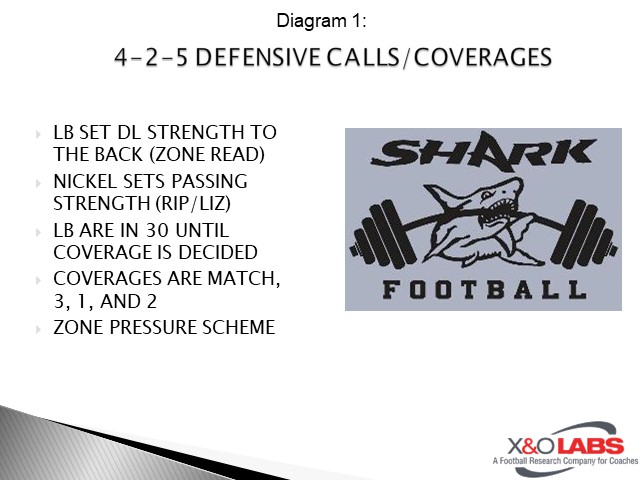By P.J. Gibbs
Defensive Coordinator/DB Coach
Gulf Coast High School (FL)
Twitter: @coachpjgibbs
Introduction
The RPO and the spread offense is constantly evolving. Defenses have to adapt and find different ways to attack the RPO and give the QB's and their OC’s different looks and reads. As a defense, you need to adapt to your personnel and what type of pressures work best for you with your players. In this report, we will look at different coverages and pressures that have been effective for us at Gulf Coast in the past two seasons.
Match Coverage vs. RPO’s
We employ multiple coverages against the RPO’s that are common here in southwest Florida but the first coverage, and the most efficient, that we teach is Match Coverage. We use Rip/Liz Match to defend RPO’s because it confuses the QB’s RPO Read. We must force the QB to hand the ball off and not have the option to pass. That is why we always start in a 2-high to give an illusion of open middle of the field and uncovered slot. It is imperative to drill your secondary into being disciplined and become great open-field tacklers in this defense scheme because the QB may throw the ball anyway. Your secondary needs to understand landmarks and angles to ensure the defense is played correctly.

Pattern Match Cover 3 can turn into man coverage based upon the releases of the receivers. There are many benefits to matching routes post-snap after the pattern distribution. The first benefit is that it allows you to take the “air” out of the zones. The zones are no longer based upon areas on the field, but are now based upon the pattern distribution and the receivers releases and spacing on the field. No longer are defenders “spot” dropping and covering areas. They are playing tight coverage on the receiver in their zone. It forces the QB to be more accurate and precise with his throws.
Benefits of Playing Match Coverage vs. RPO’s
- Allows defenders to contest balls through receivers’ hands
- Gives answers to all different route patterns
- Allows a defense to handle vertical routes with a single high safety coverage structure
This is a split safety coverage that is pattern matching what routes the offense runs at you in a game. Since we are a 4-2-5, we play with a Viper, who is our hybrid player, he can play the run as well as cover a slot or a tight end. If we see 10 personnel in match, we will send the Viper to the passing strength, which generally is our defensive left, due to a right-handed QB. If the QB you’re facing is a lefty, then send him to the defensive right. Our two linebackers will be in “30” techniques, with the Viper will be head up to inside leverage on the #2 receiver. The Corners will be 1x5 outside leverage, pre-snap, they will then slide to a head up technique on the snap. The Safeties will be at 10 yards on the Hash, pre-snap. Our two Safeties will make a “Rip” or “Liz” call depending where the Viper is against 10 personnel. If the Viper is to our defensive left, we will then make a “Rip” Call, meaning on the snap the right safety will come down to LB depth over the #2 Receiver.









